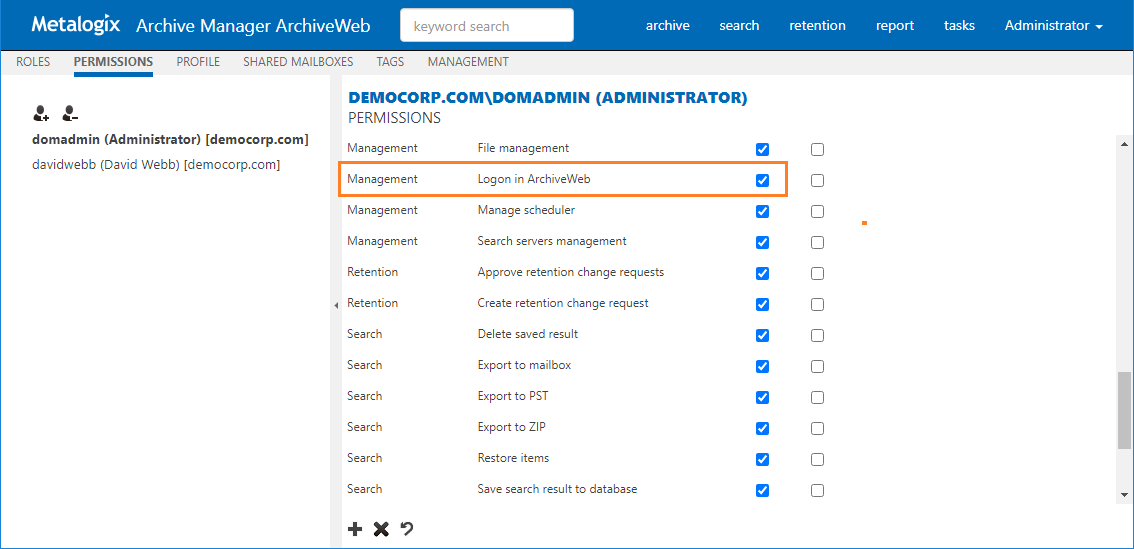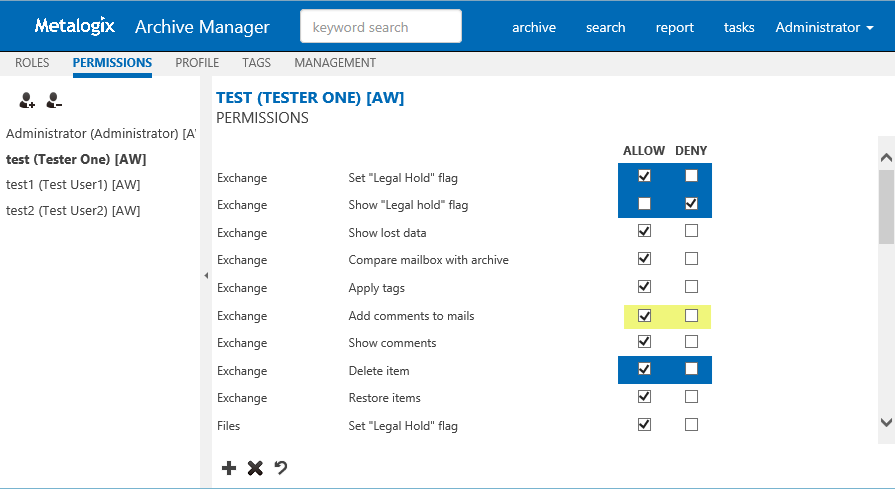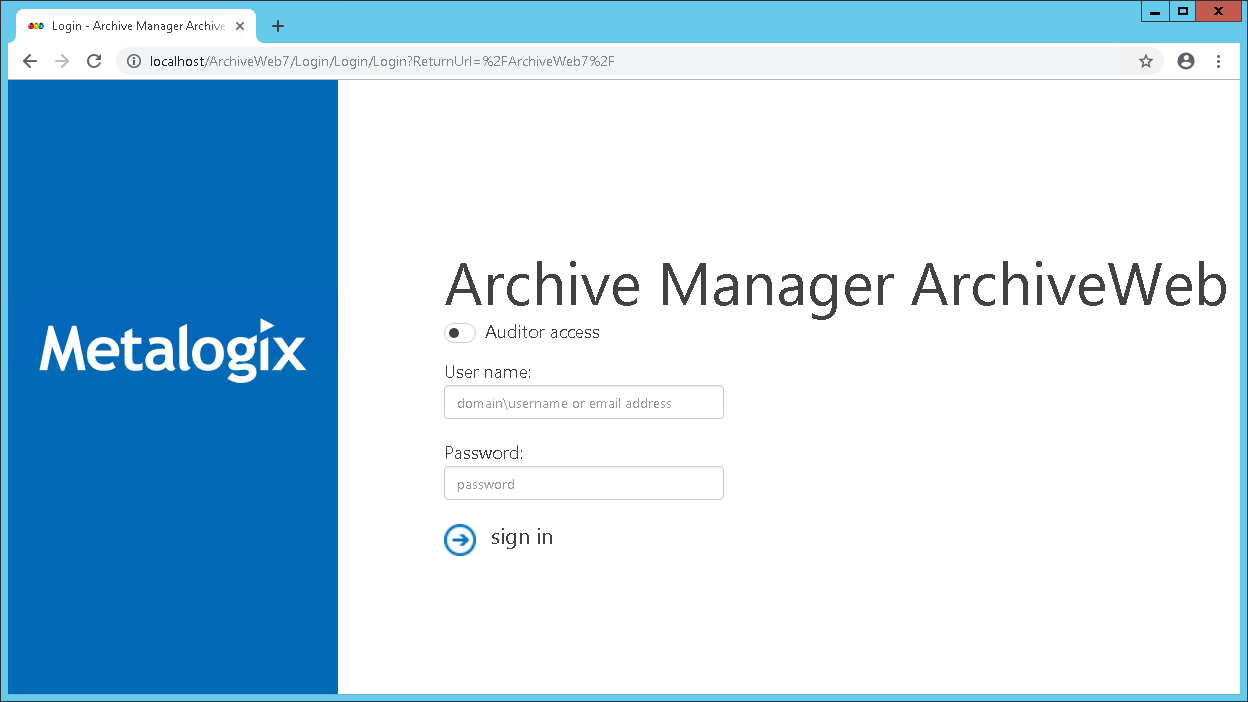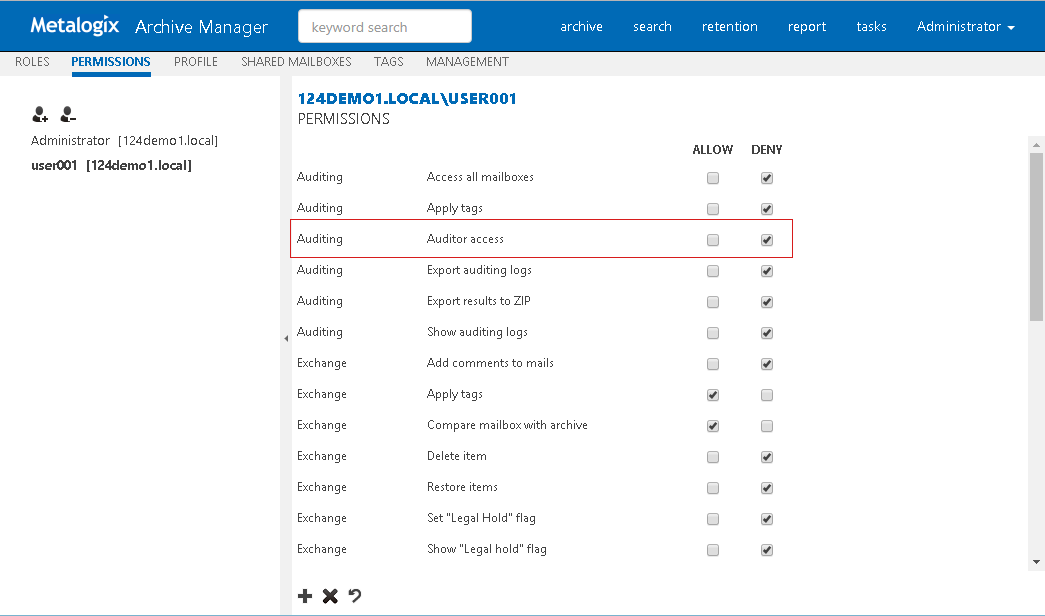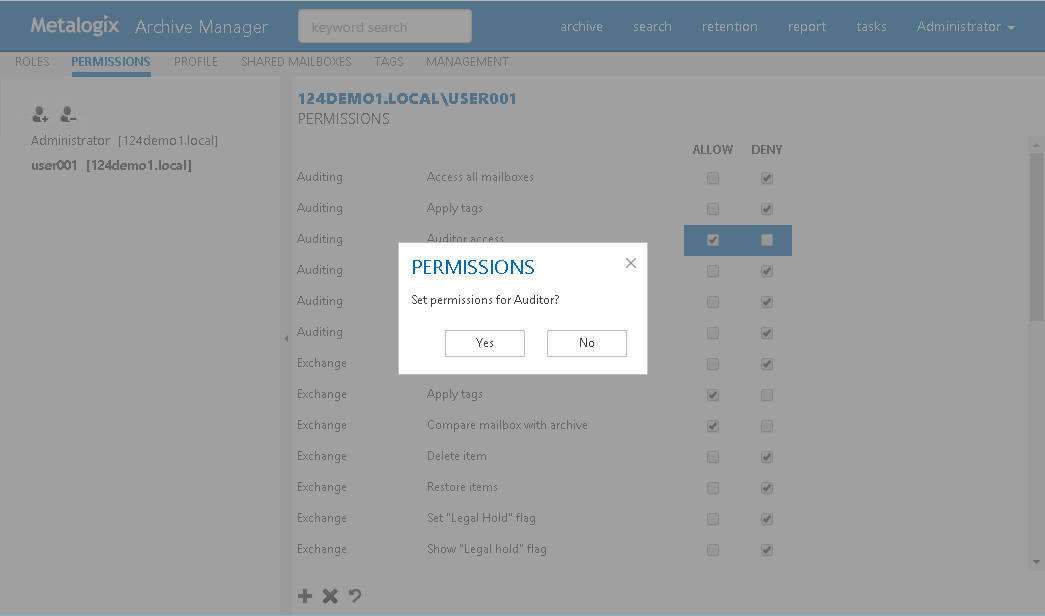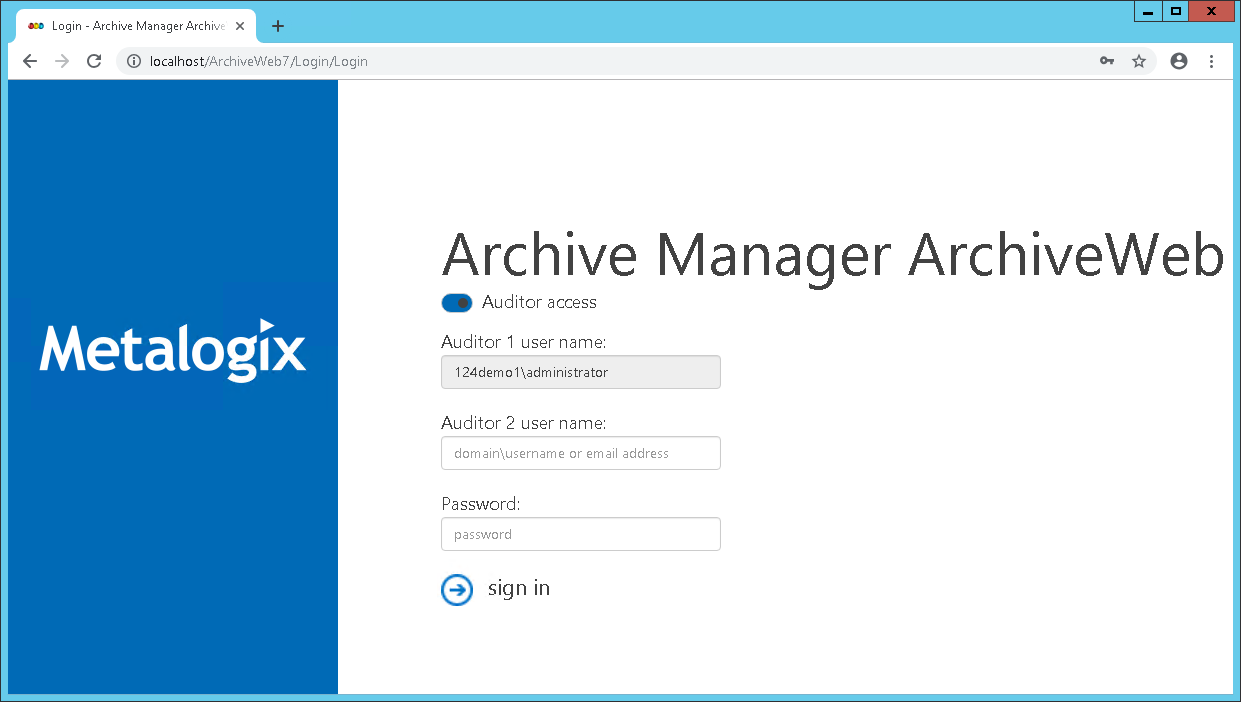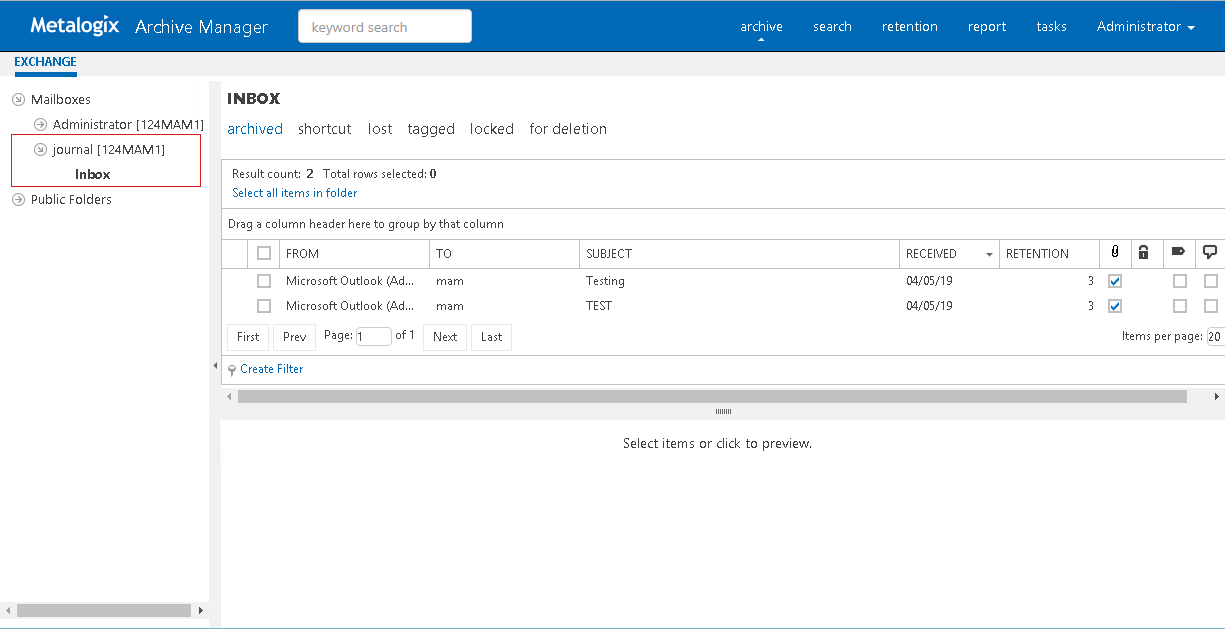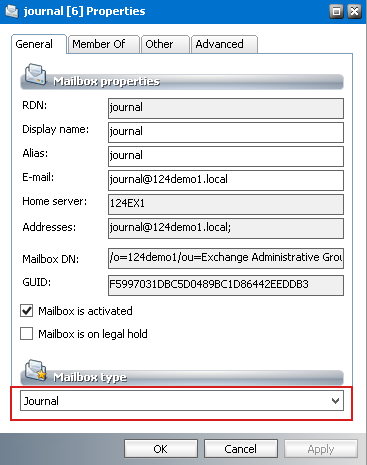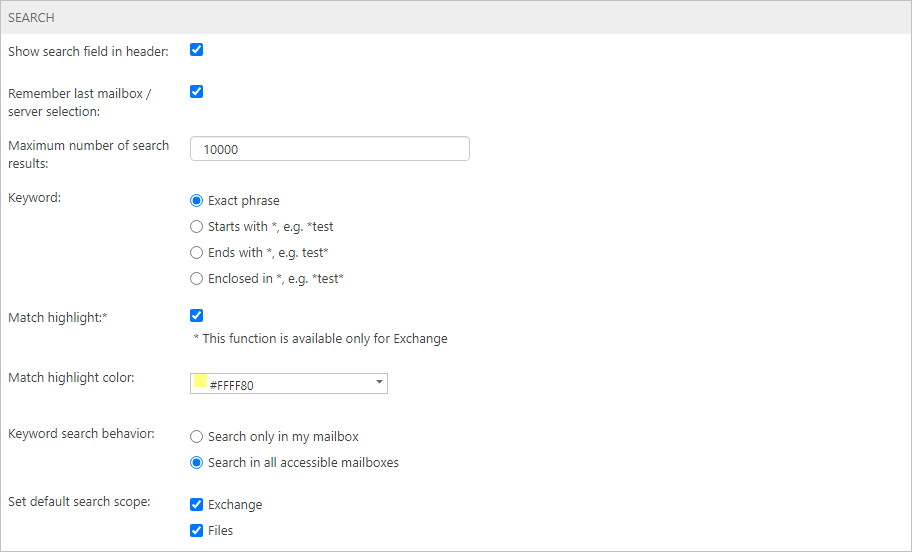Permissions
To display the Permissions page, click the logged-on user name in the right-upper corner. Select Manage settings from the drop-down menu, then click Permissions on the grey sub-bar. Now you can assign ArchiveWeb permissions to users/groups in the main pane.
Super-user has ability to control access list, i.e. who is allowed to log into ArchiveWeb. Super-user has to set user and/or group who has permission to log in ArchiveWeb. The affected permission is Logon in ArchiveWeb and can be set in Manage settings in Roles and/or Permissions sites:
Default permission is ALLOWED user is allowed to log in ArchiveWeb.
Users/groups which already have some roles assigned manually are listed on the right. Click the user/group to display and manage its roles in the right pane. List of roles in the right pane is split into sections - Exchange Archive features are listed under Exchange roles, search features under Search roles etc.
NOTE: Users deleted in Active Directory but still existing in Archive Manager are displayed as strikethough.
To assign roles to users/groups:
1.Select the desired user on the right. If the user is not listed, click the Add user or group symbol (
2.In the Find users or groups pop-up dialog choose whether youd like to search in Office 365 users or in Active Directory users.
To search in Office 365 users check Office 365 user checkbox. User can be searched by user-name, logon-name or display-name. Asterisk (*) wildcard can be used.
Note: Office 365 users need to be previously imported via Archive Manager for Exchange.
To search in Active Directory users leave Office 365 user checkbox unchecked. Enter domain name and user/group name. Asterisk (*) wildcard can be used.
When fields are filled by clicking the Search button search in desired category is invoked.Select the desired users/groups in the search results and click OK.
3.The selected user/group appears in the left pane. Select the user/group to manage its ArchiveWeb permissions in the right pane.
4.List of roles on the right is split into sections. Exchange Archive features are listed under Exchange roles, search features under Search roles etc. Further, each role can be allowed/denied on global level or on individual archive server level. Permissions which are set manually are highlighted in blue. Inherited permissions are highlighted in yellow. (More information on permission hierarchy find at the beginning of this chapter.)
To remove users/groups:
1.Click the Remove users or groups symbol (
2.In the Remove users or groups pop-up dialog select users or groups youd like to remove.
3.Click OK.
Allow all (



Permissions list
The table below lists default users ArchiveWeb permissions. They are managed under Roles and Permissions.
|
Role |
Default value | |
|
Auditing |
Show auditing logs |
Denied |
|
Auditing |
Export auditing logs |
Denied |
|
Auditing |
Apply tags |
Denied |
|
Auditing |
Access all mailboxes |
Denied |
|
Auditing |
Export results to ZIP |
Denied |
|
Auditing |
Auditor access |
Denied |
|
Compliance |
Allow policy managed download |
Denied |
|
Compliance |
Compliance management |
Denied |
|
Exchange |
Set "Legal Hold" flag |
Denied |
|
Exchange |
Show "Legal hold" flag |
Denied |
|
Exchange |
Show lost data |
Allowed |
|
Exchange |
Compare mailbox with archive |
Allowed |
|
Exchange |
Apply tags |
Allowed |
|
Exchange |
Add comments to mails |
Denied |
|
Exchange |
Show comments |
Denied |
|
Exchange |
Delete item |
Denied |
|
Exchange |
Restore items |
Denied |
|
Exchange |
Show own mailbox |
Allowed |
|
Exchange |
Show shared mailbox |
Allowed |
|
Exchange |
Show public folders |
Allowed |
|
File |
Set "Legal Hold" flag |
Denied |
|
File |
Show "Legal hold" flag |
Denied |
|
File |
Apply tags |
Allowed |
|
File |
Compare file system with archive |
Denied |
|
File |
Find files without shortcut |
Denied |
|
File |
Add comments to files |
Denied |
|
File |
Show comments |
Denied |
|
File |
Delete files |
Denied |
|
File |
Restore files |
Denied |
|
File |
Show files server |
Allowed |
|
Journaling |
Access journal |
Denied |
|
Management |
Extend retention time |
Denied |
|
Management |
Configure Files servers |
Denied |
|
Management |
File management |
Denied |
|
Management |
Manage scheduler |
Denied |
|
Management |
Search servers management |
Allowed |
|
Management |
Logon in ArchiveWeb |
Allowed |
|
Retention |
Approve retention change requests |
Denied |
|
Retention |
Create retention change request |
Denied |
|
Search |
Search mails |
Allowed |
|
Search |
Search files |
Allowed |
|
Search |
Save search result to database |
Allowed |
|
Search |
Export to mailbox |
Denied |
|
Search |
Export to PST |
Denied |
|
Search |
Export to ZIP |
Denied |
|
Search |
Delete saved result |
Allowed |
|
Statistics |
Mails - Show statistics |
Denied |
|
Statistics |
Files - Show statistics |
Denied |
|
Statistics |
Export statistics |
Allowed |
Auditor Access
Journals in Exchange Server are used to enforce legal, regulatory, and organizational compliance in organizations by recording all or targeted email messages. In addition to journals, mailbox audit logs are also used to track who logs on to the mailboxes in your organization and what actions are taken by delegate users.
Auditor Access grants users the ability to view all mailbox journals that are imported, audit logs, retentions and search. Use this powerful feature with discretion.
To use this feature you must grant Auditor access permissions to at least two users. The two-user authentication mechanism works as follows: If John wants to log in as an auditor, he must have the Auditor access permission, and he must able to specify the user name of another user who has the Auditor access permission, before he can successfully log in as an auditor.
Steps to grant the Auditor access permission to a user
1.Log in to Metalogix Archive Manager ArchiveWeb with the credentials of a user who has the ability to grant permissions to other users.
2.From your account name drop down, select Manage Settings.
3.Select the Permissions tab.
4.Click the Add User icon and locate the user from the Find Users or Groups search window.
5.Select the user from the user list on the left to display the permission set in the right-hand pane.
6.Select the check box for Auditor access.
|
|
NOTE: No user is granted this permission by default. As a result auditor access is denied to all users including the super-user. |
7.In the confirmation dialog that appears, click Yes to grant the Auditor access permission.
|
|
NOTE: Granting the Auditor access permission automatically grants all permissions of type Auditing. |
8.Repeat the above steps to grant the Auditor access permission to at least one or more users as needed.
Steps to log in as an auditor
1.If you have the Auditor access permission, enter your user name and password in the ArchiveWeb log in page.
2.Toggle the Auditor access button to turn on the feature. Notice that the user name field label changes to Auditor 1 user name. This is the account that will be used to log in as an auditor.
3.Click sign in. The Auditor 2 user name field appears.
4.Enter the user name of another user who has the Auditor access permission.
5.Click sign in again.
6.If the two-user authentication succeeds, the Metalogix Archive Manager workspace appears.
7.From the top bar, click archive to open the archive view.
8.Click the Exchange tab.
9.Expand the Mailboxes node and select a journal to view its contents.
|
|
NOTE: If you have added a journal mailbox but cannot see its contents, check the Mailbox type property of the mailbox. To specify a journal type mailbox follow the steps below: 1.Select the journal mailbox, and right-click to open the context menu 2.From the context menu select Properties to open the Properties window. 3.In the General tab, locate the Mailbox type property. 4.Set this value to Journal by selecting the value from the drop down. 5.Click OK to confirm the change and return to the mailbox. |
Profile
The Profile page helps you set the display preferences of logged in users.
In this topic:
·Steps to open the Profile page
·Steps to customize the profile
PROFILE HOMEPAGE
PROFILE SETTINGS
Steps to open the Profile page
1.Log in to ArchiveWeb.
2.Click your username from the top-left corner.
3.Select Manage settings from the drop down.
4.Click Profile from the local menu bar and click Settings.
To create a default profile:
When the administrator or super-user changes the default settings and Home page choices the administrator must click Set as default at the bottom-right of the page. These settings will be updated in the database as serves as the most current default settings.
To set a default profile for all users:
When a default profile exists, click Set default values for all users at the bottom- right of the page. By clicking this button all user profiles stored in the database will be replaced by the latest default settings. For users who do not have a stored profile, the latest default profile will be used. Personalized shared mailboxes and tags stored in the users profile will not be replaced.
Steps to customize the profile
To customize a personal profile:
When a user makes changes to the settings or Home page tabs, the user must click Apply changes at the bottom-right of the page, to save the customized profile in the database.
To reset a profile:
The user can click Reset at the bottom-right of the page, to replace their profile with the latest default profile from the database. Personalized shared mailboxes and tags stored in users profile will not be replaced.
Under the Home Page node select which page should be displayed after you log in to ArchiveWeb.
·Under Language select the desired language for the application (The default language depends on the Windows local setting of the Archive Manager server.) NOTE: For this change to take effect, re-login is required.
·Date/Time format - select you preferred date and time format for the whole UI; default value depends on regional settings of your machine and the language selected in the Profile; when profile language is changed, date/time format is changed accordingly
·Maximum preview size [MB] sets maximum file size that can be opened in a preview-pane. Displaying large item (with size more than 20MB) can cause out-of-memory exception. Default value is 20 MB.
·Automatic refresh interval (in seconds) - determines how often the Tasks list will be refreshed. Setting small intervals may cause performance issues. The default interval is 10 seconds.
·Delete completed task - select this check box to automatically delete completed task which do not return a value like database tasks such as Add/Remove Tag, Set/Unset legal hold flag, Mark for deletion and Extend retention time. If the check box is not checked all completed tasks will be listed.
·Show search field in header - select this check box to display the keyword search field in the page header. Clear this check box to hide the keyword search field in the page header. The Administrator can permanently hide the keyword search in the page header by adding the ShowTopSearchPanel key in the Web.config file. The default folder is C:\Program Files (x86)\Metalogix\ArchiveWeb.
<appSettings>
...
...
<add key="ShowTopSearchPanel" value="false"/>
</appSettings>
When the key value is set to false, the Show search field in header setting will not be available in the Profile page and users will not be able to display the keyword search field.
·Remember last mailbox / server selection - If this check box is checked, and Metalogix Archive Manager for Exchange is installed, all mailboxes that were selected in the previous search operation are selected by default in Search > Mailboxes for subsequent search operations as long as the user has permissions to search those mailboxes. If the check box is not checked the user must select the mailboxes before a search operation. If this check box is checked, and Metalogix Archive Manager for Files is installed, all servers that were selected in the previous search operation are selected by default in Search > Servers for subsequent search operations as long as the user has permissions to search those servers. If the check box is not checked the user must select the servers before a search operation.
·Maximum number of search results - determines the maximum number of search results are returned from a search.
·Keyword - choose a wildcard format to use with the keyword search.
oExact phrase - no wildcards are added. The user can add a wildcard manually if needed.
oStarts with * - A wildcard is added at the beginning of a keyword e.g. *sunshine
oEnds with * - A wildcard is added at the end of a keyword e.g. sunshine*
oEnclosed in * - A wildcard is added at the beginning and end of a keyword e.g. *sunshine*
·Match highlight - Select this check box to highlight the search phrase in the search results. Available only for Metalogix Archive Manager for Exchange.
·Match highlight color - color picker to choose a color for the highlight.
·Keyword search behavior - sets the default Search scope for keyword search setting in the Search tab only for Metalogix Archive Manager for Exchange. Choose from the following options:
oSearch only in my mailbox - by default only the logged on users mailbox is pre-selected for a keyword search operation.
oSearch in all accessible mailboxes - by default all accessible mailboxes are pre-selected for a keyword search operation.
·Set default search scope - Choose the default search scope for keyword search.
oExchange - allows you to search in archived emails. Available if Metalogix Archive Manager for Exchange is installed.
oFiles - allows you to search in archived files. Available if Metalogix Archive Manager for Files is installed.
Maximum text length - the Treeview's node text will be trimmed to the number of characters specified.
·Paging - select Endless paging to display all items on one page. Select Show paging to limit the number of items on one page.
·Journal highlight color - choose a color from the color picker control to highlight the journal items.
·Items per page - If Show paging is selected, set the number of items to be displayed per page This number applies to the full grid view.
·Columns - sets the columns and the order that they are displayed in a list.
oArchive - These column headers are used in the Archive page: Select All, From, To, Subject, Received, Retention, Attachment, Locked, Tagged, Commented
oSearch - These column headers are used in the Search results page: Select All, From, To, Subject, Folder, Received, Version, Attachment, Locked, Tagged, Commented
·Show inactive mailboxes - select this check box to display inactive mailboxes in Archive and Search views. The Administrator can override this setting by ShowNotActiveMailbox key in the Web.config file. The default folder is C:\Program Files (x86)\Metalogix\ArchiveWeb.
<appSettings>
...
...
<add key="ShowNotActiveMailbox" value="true"/>
</appSettings>
When the key value is set to true, all users will have permission to show inactive mailboxes.
·Use grid view - allows users to set the list view type.
oSimple - (default grid type) Select this option so that list operations such as custom filters, sorting and ordering are performed on items currently displayed in the list as defined by the Items per page option in the Grid settings or in the table itself (see the List view conventions section). Using Simple grid dramatically improves the list performance especially when working with a large number of items. Simple grid can be used only for Archive views.
oFull - Select this option so that list operations such as custom filters, sorting and ordering can be performed on the entire data set of the list irrespective of limits defined by the Items per page option in the Grid settings. This option is not recommended for huge data sets. Full grid can be used in Auditing and Search result lists.
·Columns - sets the columns and the order that they are displayed in a list.
oReport - These column headers are used in the Archive page: Select All, Log level, Log date, Method, Computer, User, Category, Tagged
·Use grid view - allows users to set the list view type.
oSimple - (default grid type) Select this option so that list operations such as custom filters, sorting and ordering are performed on items currently displayed in the list as defined by the Items per page option in the Grid settings or in the table itself (see the List view conventions section). Using Simple grid dramatically improves the list performance especially when working with a large number of items. Simple grid can be used only for Archive views.
oFull - Select this option so that list operations such as custom filters, sorting and ordering can be performed on the entire data set of the list irrespective of limits defined by the Items per page option in the Grid settings. This option is not recommended for huge data sets. Full grid can be used in Auditing and Search result lists.

